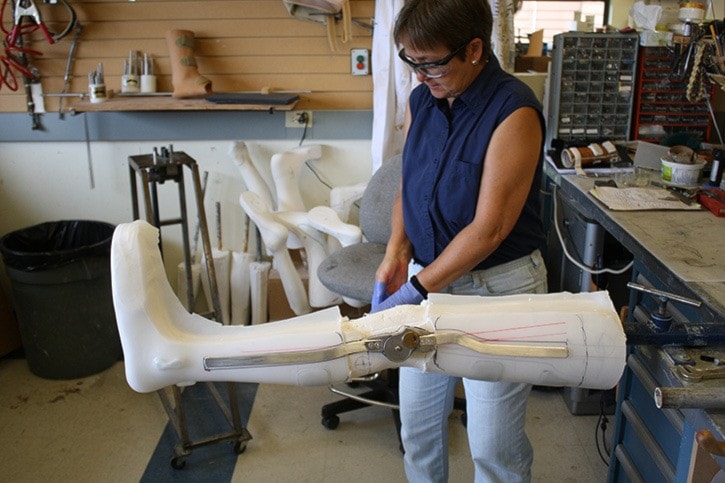The process begins with a plaster cast of a patient’s foot, knee, elbow or back. From there, a team of technicians tinker with the shoe, wheelchair or artificial limb designed from scratch for each new patient at the Queen Alexandra Centre for Children’s Health.
It’s here, in the confines of the dated Fisher Building, where customized orthotics, prosthetics and seating take shape for 10,000 people each year. In most cases, it’s the only such facility that can offer the necessary expertise to help patients rebuild their lives.
“Perhaps because we’re tucked away in this location, our services aren’t very well known, not only within the community but even in the overall healthcare community,” said Al Plouffe, program co-ordinator.
Plouffe oversees a team of 30 in Fisher Building, where patients range from seniors with spina bifida or scoliosis to child amputees to athletes recovering from sports injuries.
“We do all body parts, spinal, neck, arms, elbows, legs, knees, it goes on and on,” said Pat Whitby-Bailey, a certified orthotist and supervisor of her department. “Everything we do is specific to a function.”
The orthotics team builds braces for patients with conditions like cerebral palsy, club foot or those recovering from a stroke. Thigh corsets, plastic pieces of knee and ankle braces and buckets of plaster scatter the shelves of the half-dozen workshop rooms.
“We’ll take a cast of the affected area if the patient can’t be fitted with something off the shelf,” Whitby-Bailey says.
Customized braces take days to complete, and technicians begin by filling a patient’s cast with plaster for a negative mould.
“This room is where the thinking happens. You can slap a brace on somebody, but if you haven’t thought about what you want the brace to do for them, it can be successful or not very successful,” Whitby-Bailey says.
Protruding from the custom mould is a steel pipe that clamps the cast in place as technicians rework plaster over bony contact points and shave other spots down with rasps. The intention is a flawless design that distributes as much pressure as possible once a brace is formed.
“There’s so much thought rolled into one device,” Whitby-Bailey says.

Plastics vary depending on the patient. A six-foot-six volleyball player recovering from a knee injury might need a brace that can handle more swelling and kinetic energy than a hip orthotic for a frail senior.
“We normally use polypropylene, that’s our main plastic,” Whitby-Bailey says. “It’s relatively cheap and easy to form.”
The cloudy plastic sheet is put into an industrial pizza oven and left to soften “to the consistency of a slow-moving toffee” until it turns clear. It’s then quickly transferred to the cast, where technicians smooth out wrinkles before a vacuum suctions the mould to perfection.
“It takes about five hours to reach this stage, and we still need to buff the edges, make straps, put pads and hinges on it,” Whitby-Bailey says. “People wonder why it’s so expensive, but they don’t see what we do to get here.”
Across the hallway, dozens of wheelchairs sit in the centre of a room as technicians skirt between workbenches on rolling stools.
The Seating department customizes wheelchairs for people with conditions ranging from muscular dystrophy to brain injuries, and technicians rely on a deep toolbox that includes welding, plastics and electronics that can vary by patient need.
Creative product design is key, as technicians work with “distorted bodies with very, very limited motion,” Whitby-Bailey says. “People who spend all day in their wheelchairs are susceptible to pressure ulcers, and that’s a huge cost on the medical system. Customizing their seat helps with that.”
Everything from a flat tire to programming a “blow-and-puff” wheelchair drive system is completed here for patients across Vancouver Island.
On the floor of an adjacent workshop, metalworking machines hum steadily.
Two industrial sewing machines from what look like the cusp of the 20th century sit in the centre of the space.
“It’ll punch right through leather or soles of shoes,” Whitby-Bailey says.
Nearby, prosthetic fabrication specialist Brenda Davies picks up a plaster limb and walks it towards her workstation.
Davies slips pieces of fibre glass nylon over the thigh stump until the sock is thick enough for a hot treatment of chemicals that binds them together.
“We’ve got a 300-pound guy who loves hunting out in the bush, so we use carbon fibre for his liner,” Davies says. “It all depends on the function.”
Accurate skin colour is one of the most difficult steps in the process, says Davies, as she pans through swatches then grabs a pink-hued paint in a small squeeze jar.
“I’ve got pigment for every skin tone, but Caucasian is the hardest to get right,” she says. “If you’re Native or East Indian, I use a little bit of black to try to get that tone correct.”
Back in Plouffe’s office, he speculates that the lack of widespread awareness about Queen Alexandra’s services stems from its pediatric medicine origins. In the early 1990s, adult prosthetic and orthotic services at Royal Jubilee Hospital were shut down and integrated into children’s services in the Fisher Building. A recent addition includes a high-tech gait analysis centre to assist in the design of custom pedorthics.
“We have all these different professionals in one building who are all inter-related. We have patients who may see three different clinicians in one visit,” Plouffe says. “We’re the only facility like this on the Island and one of just a handful in the province. We’re very proud of what we do.”
Learn more about Queen Alexandra Orthotics, Prosthetics and Seating program at viha.ca/qaops.
Read Part 1 of the series on two-year-old patient Tytan Beckford.
editor@saanichnews.com
